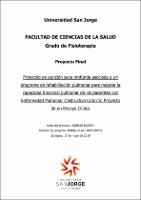Please use this identifier to cite or link to this item:
https://repositorio.usj.es/handle/123456789/228
| Title: | Protocolo de punción seca profunda asociada a un programa de rehabilitación pulmonar para mejorar la capacidad funcional pulmonar de los pacientes con Enfermedad Pulmonar Obstructiva Crónica: Proyecto de un Ensayo Clínico |
| Authors: | Blondy, Aurélie |
| Keywords: | Punción Seca; Aguja; Enfermedad Pulmonar; Obstructiva Crónica; Rehabilitación; Fisioterapia |
| Issue Date: | 2019 |
| Abstract: | Introducción: La Enfermedad Pulmonar Obstructiva Crónica (EPOC) es una patología que impacta considerablemente la vida diaria de los pacientes. Los beneficios de la Rehabilitación Pulmonar (RP) han sido demostrados en el tratamiento de la EPOC pero existen pocos estudios que han probado la eficacia de técnicas de punción seca para relajar la musculatura respiratoria. Objetivos: Evaluar la eficacia de la aplicación de punción seca asociada a un programa de RP para mejorar la capacidad pulmonar, así como la calidad de vida y el estado físico y psicológico de sujetos con EPOC. Material y métodos: Se reclutará a pacientes con EPOC, en hospital y asociación. Los participantes serán aleatorizados en 2 grupos: Grupo Control (RP); Grupo Experimental (RP + punción seca). La intervención durará 12 semanas. Se valorará la capacidad funcional pulmonar mediante espirometría, la calidad de vida mediante el Cuestionario Respiratorio de Saint George, el nivel de ansiedad y de depresión mediante la Escala de Ansiedad y Depresión Hospitalaria, el dolor con el Inventario Breve de Dolor, el umbral de dolor utilizando un algómetro, la fuerza muscular mediante Presiones Inspiratoria y Espiratoria Máxima, la disnea con la Escala Modificada del Consejo de Investigación Médica, la saturación utilizando un oxímetro y la capacidad de ejercicio mediante la prueba de caminata de 6 minutos. Se recogerán valores al inicio del estudio, a las 2, 4, 12 y 24 semanas. Se considerará estadísticamente significativo un p<0,05. Resultados esperados: Una mejora de la capacidad funcional pulmonar. Se esperan también cambios positivos a nivel de: calidad de vida, disnea, dolor, saturación y capacidad de ejercicio de los pacientes. Conclusión: Se espera comprobar que la aplicación de punción seca puede ser útil como complemento de la RP en el tratamiento de los pacientes con EPOC. |
| Description: | Introduction: Chronic Obstructive Pulmonary Disease (COPD) is a pathology that impacts on patients' daily lives considerably. The benefits of Pulmonary Rehabilitation (PR) have been demonstrated in the treatment of COPD but there are few studies that have proven the efficacy of dry needling techniques in relaxing respiratory musculature. Objectives: Assessing the efficacy of dry needling application associated with a RP programme to improve lung capacity, as well as quality of life and physical and psychological status of patients with COPD. Material and methods: COPD patients will be recruited in hospitals and organizations. Participants will be randomized into 2 groups: Control Group (that will receive RP); Experimental Group (that will receive RP and dry needling). The intervention will last 12 weeks. Pulmonary functional capacity will be assessed using spirometry, quality of life using the Saint George Respiratory Questionnaire (SGRQ), anxiety and depression level using the Hospital Anxiety and Depression Scale (HADS), pain using the Brief Pain Inventory (BPI), pressure pain threshold using an algometer, muscle strength using Maximal Inspiratory Pressure (MIP) and Maximal Expiratory Pressure (MEP), dyspnea using the Modified Medical Research Council Scale (mMRC), saturation using an oximeter and exercise capacity using the 6 Minute Walking Test (6MWT). Values will be collected at the beginning of the study, at 2, 4, 12 and 24 weeks. A p<0.05 will be considered statistically significant. Expected results: An improvement in pulmonary functional capacity. Positive changes are also expected at the level of: quality of life, dyspnea, pain, saturation and exercise capacity of the patients. Conclusion: It is expected that the application of dry needling may be useful as a complement to RP in the treatment of COPD patients. |
| URI: | https://repositorio.usj.es/handle/123456789/228 |
| Appears in Collections: | Grado en Fisioterapia |
Files in This Item:
| File | Description | Size | Format | |
|---|---|---|---|---|
| Protocolo de punción seca profunda asociada.pdf | 1,36 MB | Adobe PDF |  View/Open |
This item is licensed under a Creative Commons License

